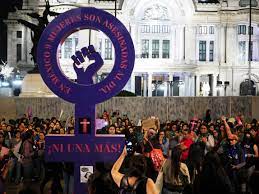The Fight Against Femicide

Protests across Mexico erupt after years of targeted attacks towards women
Just last year, 939 women were killed by homicide in Mexico. The statistics aren’t shocking, for femicide -the term coined to describe the misogynistic attacks and murders of women- has run rampant in the country for decades. Activists state that the Mexican government has failed to acknowledge the heightened threat of physical and sexual violence towards women in the country, and took to the streets on International Women’s Day to protest the attacks [The Washington Post].
Ahead of the protests, Mexican President Andrés Manuel López Obrador dismissed the claims of femicide in the country, “arguing they were spurred by his conservative opponents,” as told by The Washington Post. His strained relationship with the feminist movement, support for politicians accused of sexual assault, and years of little to no action taken against femicide are what led activists to take to the streets on March 8.
Obrador installed a “peace wall” around the presidential palace before the planned protests began, claiming that it was meant to prevent vandalism [The Guardian]. However, activists argue that the wall “was symbolic of the president’s refusal to take on the issue.” In response, activists painted the names of hundreds of victims across the barrier, turning it into “a makeshift billboard for their movement” [NBC].
While the protests started off peaceful, they did become violent as the march went on. Activists and police were engaged in physical altercations at the palace barricades, and pepper spray was used against the protesters. In an official report from the city’s government, 62 officers and 19 civilians were injured; However, the government “categorically denied” using any form of gas during the events, as told by The Guardian.
Through the violence, women made their powerful stance against femicide and the lack of response they have seen from the government. 19 year-old activist, Vania Palacios, held a sign that read ‘Fight today so not to die tomorrow.’ “We want him to protect us the same way he’s protecting these buildings,” said Palacios, alluding to the barricades around the palace.
Femicide is not only present in Mexico. Women in Algeria took to the streets on March 8 as well to protest the heightened violence in their country [The African Report]. Reports are now stating that the recent murders of eight Asian women in Atlanta is tied to both the increased racist attacks against the Asian community and deep-rooted misogyny [MSNBC].
The recent murder of Sarah Everard in South London at the hands of police officer Wayne Couzens has sparked massive outrage on social media, adding to fuel of global movement. “She wore bright clothing, took the quickest/safest route home, and was on the phone with her boyfriend so there was still some form of company. And there’s still victim blaming,” said twitter user @HayMcKinney.
Demand for change in Mexico, and across the world, is not going to go away. On average, 10 women a day die from physical or sexual violence in Mexico, and there will be no change unless the public takes action. “I have seen it throughout history in the peaceful marches of women,” said 49 year-old protestor, Ivette Granados. “They did not give any results…I think that these things make governments and people turn around,” [The New York Times].

